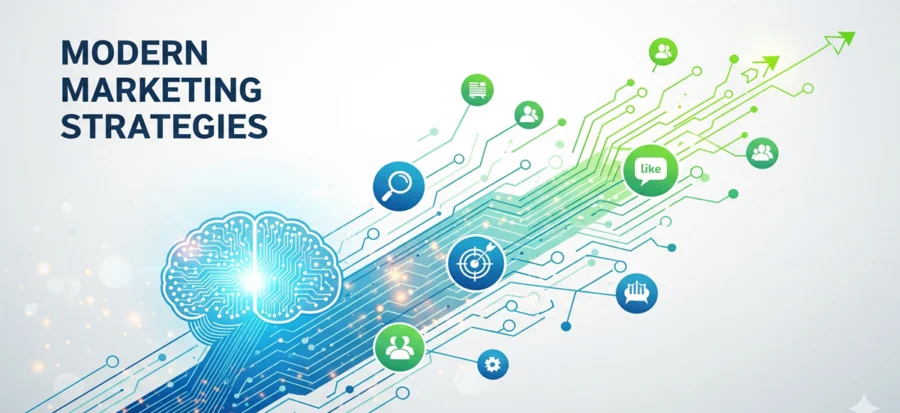Modern Marketing Strategies: Beyond Ads, Memes, and Slogans
When most people think of marketing, they immediately picture catchy ads, flashy logos, viral social media memes, and website pop-ups. These are the visible parts of marketing that dominate the internet. While they may generate short-term buzz, they rarely build long-term trust or sustainable growth.
This is where modern marketing strategies come in. Unlike surface-level tactics, modern approaches combine branding, consumer psychology, data analysis, customer journey mapping, and community building. They focus on creating meaningful connections and building trust on a human level rather than just shouting the loudest in a crowded marketplace.
In this blog, we’ll dive deep into what makes modern marketing strategies effective, why old assumptions no longer work, and how businesses of every size can implement them to achieve long-lasting success.
Why Outdated Marketing Assumptions Fail
Traditional views of marketing revolve around activities such as:
- Paid ads on Google or social media
- Catchy slogans and jingles
- Press releases for media coverage
- Email blasts with generic offers
- Posting memes to get viral attention
While these can create visibility, they don’t create relationships. Without trust, personalization, or value, audiences lose interest quickly.
Businesses that rely only on these methods often burn through budgets without achieving consistent results. Modern marketing strategies solve this problem by aligning campaigns with customer needs, behaviors, and values.
Core Principles of Modern Marketing Strategies
To understand the difference, let’s explore the core principles that define effective modern approaches:
1. Consistent Branding Across All Channels
Customers interact with brands across multiple platforms—websites, emails, social media, and even offline events. If the messaging or visuals feel inconsistent, it damages credibility. Modern marketing strategies prioritize unified branding so that businesses are recognizable and trustworthy everywhere.
2. Building Trust and Transparency
Today’s consumers value authenticity. They want to engage with brands that are transparent about their products, values, and processes. Trust-building campaigns—such as sharing behind-the-scenes stories or showcasing customer testimonials—are essential parts of modern marketing strategies.
3. Studying Consumer Behavior
Every purchase decision is influenced by psychology. By studying customer pain points, desires, and motivations, marketers can craft campaigns that resonate deeply. Data on browsing habits, preferences, and interactions help shape more personalized outreach.
4. Mapping the Customer Journey
From the moment a customer discovers your brand to the moment they make a purchase (and even beyond), they go through a journey. Modern marketing strategies emphasize mapping each stage of this journey to deliver targeted content and support at the right time.
5. Data-Driven Decision Making
Instead of guessing what might work, successful marketers rely on analytics. By tracking metrics such as website engagement, ad conversions, and attribution models, businesses can fine-tune their efforts. Data ensures that modern marketing strategies produce measurable ROI.
6. Research and Market Insights
Competitor analysis, audience surveys, and trend research form the foundation of modern campaigns. These insights prevent wasted efforts and ensure businesses adapt to evolving market needs.
7. Community Building
Rather than chasing short-term virality, brands that build communities enjoy long-term engagement. Online groups, exclusive memberships, and brand advocates amplify marketing efforts organically. This community-first approach is central to modern marketing strategies.
8. Lead Nurturing for Long-Term Sales
Rarely do customers buy after one interaction. Through personalized emails, content series, and retargeting campaigns, marketers nurture leads until they are ready to buy. This makes modern marketing strategies sustainable and relationship-focused.
Examples of Modern Marketing Strategies in Action
Apple’s Ecosystem Approach
Apple’s success goes beyond product features. Their consistent branding, seamless ecosystem of devices, and focus on customer lifestyle reflect modern marketing at its finest.
Nike’s Emotional Storytelling
Nike doesn’t just sell shoes—they sell inspiration. By focusing on inclusivity and community, Nike demonstrates how modern marketing strategies leverage emotions to strengthen brand identity.
HubSpot’s Inbound Model
HubSpot popularized inbound marketing by offering free blogs, courses, and tools. Instead of pushing sales, they nurtured trust through value. This demonstrates how modern marketing strategies can turn educational content into a growth engine.
Benefits of Modern Marketing Strategies
Businesses that adopt these approaches enjoy significant advantages:
- Higher Brand Loyalty – Customers connect emotionally, not just transactionally.
- Better ROI – Data-driven tactics reduce wasted spending.
- Improved Customer Retention – Relationships outlast campaigns.
- Enhanced Reputation – Trust builds authority in competitive industries.
- Sustainable Growth – Communities and repeat customers ensure stability.
Key Features of Modern Marketing Strategies
- Personalized experiences for each audience segment
- Integration of AI, automation, and analytics
- Storytelling-driven campaigns instead of generic ads
- Consistency across all digital and offline touchpoints
- Social proof through reviews and case studies
- Focus on long-term relationships instead of quick wins
How to Implement Modern Marketing Strategies
If you’re looking to transform your approach, here are steps you can take:
- Conduct a Brand Audit – Review how your brand appears across channels.
- Develop Customer Personas – Understand demographics, behavior, and goals.
- Leverage Marketing Automation – Use CRMs and AI tools for personalization.
- Create a Content Ecosystem – Build blogs, podcasts, videos, and newsletters.
- Use Analytics – Track what works and double down on successful tactics.
- Engage Your Community – Encourage user-generated content and referrals.
- Nurture Leads – Don’t stop at awareness—guide customers until conversion.
Mistakes to Avoid in Modern Marketing
- Treating marketing as a one-time campaign instead of an ongoing process
- Prioritizing ads over authentic storytelling
- Focusing on short-term visibility instead of long-term trust
- Ignoring data and relying on guesswork
- Sending generic, non-personalized messages
Conclusion
Marketing isn’t just about catchy slogans or flashy ads. True success comes from building relationships, earning trust, and guiding customers through meaningful experiences.
By embracing modern marketing strategies, businesses can move beyond surface-level tactics and invest in long-term growth. With data-driven insights, consistent branding, community building, and customer-focused campaigns, modern approaches ensure that marketing is not just loud—it’s lasting.
FAQs on Modern Marketing Strategies
Q1. What are modern marketing strategies?
Modern marketing strategies are customer-focused, data-driven approaches that emphasize trust, personalization, branding, and long-term engagement rather than one-time campaigns.
Q2. How do modern marketing strategies differ from traditional ones?
Traditional marketing relied on mass communication through TV, radio, and print ads. Modern marketing strategies focus on personalization, analytics, and digital platforms to build two-way relationships.
Q3. Why is consumer behavior important in modern marketing strategies?
Studying consumer behavior helps businesses understand motivations and pain points, making campaigns more relevant and effective.
Q4. Can small businesses use modern marketing strategies?
Yes. Even small businesses can apply modern marketing strategies by focusing on branding, creating valuable content, and building strong customer relationships with affordable tools.
Q5. What role does data play in modern marketing strategies?
Data ensures campaigns are measurable, targeted, and optimized for ROI. It eliminates guesswork and allows businesses to adapt in real time.
Curious about smart transportation and digital growth? Head over to Digital Pracer’s blog and explore content that keeps you ahead of the curve!








